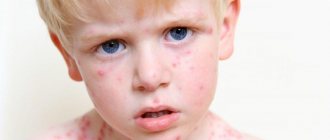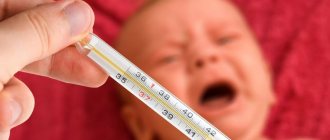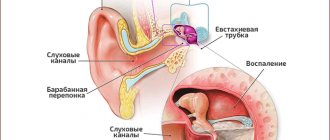Dermatological diseases can occur in both adults and children. Heat rash on the hands is a specific type of dermatitis that develops against the background of excessive sweating of the skin, that is, hyperhidrosis. If a person has excessive body sweating, he may notice red rashes on the skin of the palms, which are accompanied by itching and burning.
Miliaria develops against the background of hyperhidrosis
Features of children's heat rash
Children's skin is very delicate and sensitive, so it is easily susceptible to external influences. The skin is not even able to fully cope with heavy sweating, so sometimes you have to deal with such a phenomenon as prickly heat. It manifests itself as a small rash that looks like blisters with a whitish tint.
Such rashes are not dangerous to the child’s health if all measures are taken in time to eliminate them. Miliaria is often accompanied by severe itching. If the baby itches, there may be a risk of infection.
Causes
A baby's skin is delicate, and even the slightest irritating factors can cause it to turn red. The reason for the formation of heat rash in children under one year of age is the inability of the child’s skin to cope with strong sweat production.
In infants, the sweat glands work actively, and the ducts on the skin through which sweat leaves the baby's body are very narrow. When the baby gets hot, sweat is formed more actively, but the body does not have time to remove it.
The ducts can become clogged, then irritation occurs on the skin: bubbles of different sizes form on it: reddish with a whitish tint. They themselves are not dangerous for the child, but can cause itching. The baby scratches the irritated areas, damaging the skin. In this case, pathogenic microorganisms can enter the body, causing redness and rash.
The child overheats quickly. This can lead to:
- Actively operating heating devices;
- Excessively warm clothes that mothers wrap their baby in;
- Wearing clothes made of synthetic fibers;
- Lack of hygiene;
- Diseases that occur with high fever.
Excessive sweating in an infant can be caused by:
- Tendency to allergic reactions;
- Overweight;
- Rickets disease;
- Prematurity;
- Early transition to artificial feeding.
To avoid prickly heat, you need to eliminate irritating factors from the child’s environment, provide proper skin care, and eliminate the resulting rash through local therapy.
Varieties of prickly heat
Depending on the type of skin rash, symptoms may vary. Let's pay attention to the most common conditions.
Miliaria crystalline
Bubbles can form on the entire body or in individual areas. Their diameter is no more than 1 mm. When such elements are merged, larger affected areas are diagnosed.
If the bubbles burst and the skin dries out, peeling and crusts form. In the worst case, infection and development of pustules occurs.
Common locations for rashes are the forehead, neck, back and shoulders. Associated symptoms include swelling and itching. If a secondary infectious process develops, diaper rash may form.
Crystal prickly heat
Miliaria rubra
This form of the disease is characterized by the appearance of small nodules and blisters up to 2 mm in size. Inside each element there is a cloudy liquid; a red rim without clear boundaries is visible around it. The bubbles do not merge into one formation. A characteristic symptom is severe itching with sweating and increased body temperature.
This type of heat rash usually appears in places where the skin naturally rubs: between the buttocks under the diaper, as well as in the intercostal area.
At the base of the formations there is red inflammation. The bubbles do not merge with each other.
Miliaria papularis
This disease often occurs in hot summers with high humidity. This type of disease also manifests itself in the form of flesh-colored bubbles. Their diameter can reach 1-2 mm. They appear mainly on the abdomen, chest and sides of the body. Often the rash can be found on the arms and legs.
To a number of the main manifestations, you can add symptoms such as peeling, dry skin, severe itching, and discomfort.
Miliaria profuse
This disease appears suddenly and can disappear just as quickly. Treatment does not require the use of special therapeutic methods. Such prickly heat in children appears on the face, groin, neck fold and limbs. A rash that appears on the body indicates the presence of an uncomfortable temperature regime.
General characteristics of prickly heat
As already noted, the reasons for the formation of prickly heat in children can be a fairly large number of factors. In order to diagnose this pathological condition in time and carry out treatment, it is necessary to know how it manifests itself.
Miliaria is characterized by the appearance of a red or pink rash containing fluid. Elements of the rash can be localized on a separate part of the body or located in a generalized manner. The most favorite localization places are:
- areas of folds and bends (knees and elbows);
- groin area;
- armpits;
- buttocks;
- neck and face;
- back and upper chest.
It is worth noting that in our time, due to the use of diapers, the rash most often appears on the skin that is located underneath (on the butt). This is explained by the fact that it is the diaper that leads to excess moisture.
Differentiating miliaria from other diseases that are accompanied by the appearance of rashes is not so difficult, because it is not accompanied by other symptoms, such as:
- heat;
- burning;
- itching;
- child's irritability.
The main causes of prickly heat
There are several provoking factors for the development of this disease. These include:
- Wearing tight synthetic clothing;
- Diaper heat rash. Use of low-quality diapers and hygiene products;
- Dressing your child in clothes that are too warm in hot weather. In such situations, an excessive amount of sweat is released, which does not evaporate;
- Excessive obesity in a child can also cause heat rash. It often occurs in the area of folds on the legs, arms and neck;
- Active sweating due to increased body temperature.
To get rid of prickly heat, you first need to find the root cause of its occurrence. If all provoking factors are eliminated, the rash will go away on its own.
Causes of prickly heat on the hands
Heat rash on the hands of children and adults can have various causes, which are conventionally divided into two main groups - internal and external.
Factors of internal origin are associated with various diseases occurring in the human body. Accordingly, external causes are associated with the influence of certain environmental factors.
Internal reasons:
- diseases of the cardiovascular system;
- diseases of the central nervous system, which are accompanied by disturbances in thermoregulation;
- obesity, which may result in a rash on the palms of the hands and between the fingers;
- pathologies of the endocrine system.
The appearance of prickly heat on the hands of adults and children may be associated with pathologies of external origin.
- the use of low-quality cosmetics that do not allow moisture to fully evaporate from the surface of the skin;
- prolonged stay in a hot, dry room;
- lack of personal hygiene, which leads to blockage of the sweat glands;
- frequent wearing of special rubber protective gloves, after which the skin dries out and rashes appear on it.
Skin rashes in a child on the interdigital areas of the skin may be due to the fact that the thermoregulation system in the child’s body has not yet been sufficiently formed, which leads to disruption of the normal functioning of the sweat glands.
Symptoms and locations of rashes
Symptoms of the disease appear against the background of blockage of the excretory ducts of the child’s glands. They are the same for all children. Certain areas of the skin become covered with a small red rash. If you examine it carefully, you will notice the presence of bubbles with a clear liquid.
Miliaria can occur in a child at different ages in the least ventilated places. Most often the rash occurs:
- on the neck;
- on the back;
- on the buttocks;
- on the head.
This rash causes discomfort, as in most cases it itches. The child may become irritable, have difficulty sleeping and be capricious.
Symptomatic picture
The baby's skin begins to become covered with a rash, and hyperemic lesions appear. At this time, newborns experience sleep disturbances and anxious behavior when rashes occur. The affected skin is always moist, as sweat appears in this area.
Each place is damaged by the rash for different reasons:
- Spots on the neck appear due to poor personal hygiene and/or existing fever;
- The skin of the butt is most often affected by a tightly dressed or incorrectly changed diaper;
- The heat rash can spread to the face from the neck;
- Miliaria appears on a child’s back due to overheating and the use of poor-quality clothing and diapers.
Does the heat rash itch? Not always. It itches with certain types of illness and serious reactions of the body. Red spots usually provoke a restless itching, and small white scales may fly off the skin. Peeling fits into the symptoms of miliaria. But more often, if the rashes itch, this indicates an allergic reaction, which is a consequence of diaper dermatitis or another complication.
How to distinguish heat rash from other diseases
Manifestations of prickly heat in a one-year-old child can easily be confused with an allergic reaction. To draw the right conclusions, you should pay attention to the following points:
- Type of rash. During an allergic reaction in babies, in addition to small red spots, larger formations are noticeable on the skin, and the skin becomes inflamed and swollen. If the allergy is severe, then individual skin areas become thicker. In such situations, you should immediately consult a doctor. Baby heat rash usually does not cause inflammation, it looks like small red pimples;
- Localization area. In both cases, the locations of the rashes are different. Heat rash primarily appears under the diaper, in the area of the folds, for example, on the neck or behind the knees. An allergic rash can be noticed on the arms, stomach or cheeks.
Another proven method of determination is palpation. You need to press your finger on the affected skin: if the skin color turns pale after pressing, then this is an allergy; if not, it is prickly heat.
Area of localization of prickly heat by age
What is this - prickly heat
A baby's skin is very thin, too delicate, and therefore vulnerable. Thanks to these properties, it has better blood flow than the skin of an adult. But children's epidermis also accumulates more moisture. Miliaria in babies occurs due to the prolonged presence of sweat on the upper dermal layer, which contains urea, ammonia and salts.
Such rashes are usually characteristic of children no older than 4 years, much more often - infants. Why is that? At an early age, the sebaceous glands work well, but the ducts work imperfectly. And in moments of high sweating, children's skin simply cannot cope with the volume of moisture. The skin pores close and evaporation becomes difficult. The result is prickly heat. It appears in the form of irritations with small red spots.
How to eliminate heat rash at home
For heat rash on the head or other part of the body, no specific treatment is required. If you eliminate the provoking factors in the comfort of your home and take timely measures, it will go away on its own. A few days after the rash, the blisters with liquid dry out and then crust over. During this process, your baby's skin may itch. It is important that when scratching the affected areas there is no infection. Even a harmless rash is an open door for fungi and bacteria to enter.
Immediately after discovering a red rash similar to prickly heat, you need to act immediately:
- The baby needs to be bathed in decoctions of medicinal herbs;
- You should closely monitor the temperature;
- It is advisable to arrange air baths more often;
- You can use some pharmaceutical products: potassium permanganate, powder, disinfectant ointments, creams and solutions.
If after these measures the situation does not change, it is recommended to consult a pediatrician.
Diagnosis of prickly heat in children
Diseases such as measles, chickenpox, scarlet fever, and herpes zoster (in older children) begin with a skin rash, so such diseases should be excluded. Atopic dermatitis in children, contact dermatitis, allergic reactions (urticaria, diathesis) should be differentiated from prickly heat. And if your child has any rashes, you should definitely contact a pediatrician or dermatologist; usually a visual examination is enough to make a diagnosis.
When a fungal or bacterial infection occurs, pustules, redness and swelling appear on the skin; in complicated forms of prickly heat - ulcers, weeping cracks with a putrid odor that are difficult to treat. In this case, to determine the causative agent of the infection, it may be necessary to culture the discharge for flora and scraping for pathogenic fungi.
Use of pharmaceuticals
The pharmacy sells a large number of drugs that help eliminate this unpleasant phenomenon. Parents can soothe the child's skin with the help of special solutions, creams and emulsions.
Doctors recommend paying attention to ointments, which, despite their cheapness, turn out to be effective means for achieving a positive result;
- The most popular remedy for prickly heat is zinc ointment. It helps even in advanced cases. It should be applied to the child’s skin in a thin layer three times a day;
- An equally popular remedy is Nystatin. It can be applied simultaneously with the previous drug or separately several times a day;
- A common and effective ointment is Bepanten. It can restore a child’s skin and give it a healthy appearance.
If you cannot eliminate prickly heat on your own, then perhaps the cream was chosen incorrectly. For recommendations, you should consult a doctor.
If there is a risk of allergic reactions, then it is worth using other creams to improve the condition of the skin.
- Desitin is used to treat prickly heat in infants;
- A universal and effective remedy is Mustela;
- Sudocrem has excellent qualities;
- Herbal-based drug - Emolium.
Treatment
How to treat prickly heat in children? To eliminate skin rashes, there are highly effective medications, but first of all it is necessary to determine and remove the cause of irritation of the epidermis. A general set of rules that all parents of infants must follow:
- Wear your child only clothes made from natural fabrics. The bottom layer adjacent to the body should be cotton;
- Leaving the child regularly without a diaper and giving him air baths;
- Do not dry the child with a towel after bathing, allowing the skin to dry on its own;
- Use only special, 100% organic children's cosmetics.
If your baby’s skin is frequently or too severely irritated or if there is a profuse rash, you should show the child to a specialist.
For heat rash in children, treatment will include the use of emulsions, ointments and creams that will relieve itching and eliminate nervousness in the baby. They should be prescribed by a doctor, and before receiving a consultation, you can wipe the areas of the skin affected by the rash with cotton swabs soaked in cool water.
Traditional medicine
Home remedies that will bring relief and will not cause harm:
- A solution of baking soda, which is used to treat the child’s skin several times a day;
- A slightly pink solution of potassium permanganate: you can treat the areas where the rash appears twice or thrice a day to avoid inflammation and itching;
- When bathing a baby, you can add a small amount of starch and herb.
Ointments and creams
Among pharmaceutical products, the most popular are ointments and solutions. You can treat the affected areas of the skin with antiseptics:
- Nitrofuran;
- Chlorophyllipt.
Popular means are:
- Zinc ointment. It is applied to the skin 2-3 times a day.
- Panthenol. Has a calming effect and relieves itching.
- Bepanten. Nourishes and restores the skin, gives it a healthy appearance.
Ointments are applied to damaged areas; the duration of treatment will depend on the nature of the rash and the complexity of the lesion. If complications occur, the doctor may prescribe additional treatment with antibacterial, antifungal and immunomodulating drugs.
For children with allergies, special ointments are recommended:
- Sudocrem;
- Desitin;
- Emolium;
- Mustela.
They will soothe the baby's delicate skin and protect it from rashes.
The effectiveness of traditional medicine
Often, prickly heat on children's skin can be eliminated using folk remedies. These can be various herbal decoctions, baths with the addition of potassium permanganate, powder and soda compresses.
It is worth paying attention to the most common recipes for treating heat rash:
- To prepare decoctions, it is worth preparing calendula, chamomile and string in advance. The proportions will be approximately as follows: 3 tablespoons of herb per 10 liters of liquid. The raw materials for the medicinal bath must be added to hot water and boiled for about 20 minutes. After this, the herbal decoction must be infused for about 45 minutes. After this time, it is added to the bathtub;
- Pour potassium permanganate crystals into a glass, then fill it with boiled hot water. To better dissolve potassium permanganate, the liquid in water should be mixed with a spoon. The solution in the glass should be purple, not black. When preparing such a medicine, you need to make sure that the potassium permanganate crystals are completely dissolved. In the worst case, skin burns may occur when swimming;
- You need to use talcum powder and baby powder every time you change a diaper. First, the cleansed, affected skin of the child should be treated with baby cream or milk, then apply powder with your hand or cotton wool;
- Compresses of water and soda are made to reduce itching. You need to prepare the medicine like this: add a teaspoon of soda to 200 ml of warm water. You need to moisten cotton wool or gauze in this solution and apply a compress to the area of skin with prickly heat. You can also add baking soda to a warm baby bath. The water temperature in this case should be within 36-38 degrees.
Measures to eliminate the manifestations of prickly heat
Please note: this pathological condition in children, if it is not accompanied by complications, does not require the use of medications. All that is necessary is to eliminate the reasons that led to its appearance. Recommended:
- Monitor the room temperature. In order for the child to feel comfortable, the air temperature should not exceed 22-23 degrees Celsius. It is imperative to ventilate the child’s room daily, but this should only be done when the baby is not in the room.
- Bath your baby as often as possible, at least twice a day. In this case, it is necessary to use only boiled water, to which you can add decoctions of medicinal herbs, such as chamomile, string. But you need to be careful with herbs - you need to make sure that the child is not allergic to them. Once every two days, it is recommended to add potassium permanganate to a bath of water until a pale pink color forms. After bathing, the child needs to have air baths, which will allow the skin to breathe and excess moisture to evaporate.
- You need to dress your child in high-quality diapers of the appropriate size, which allow the skin to breathe, and replace them in a timely manner. There is no need to swaddle the baby tightly, which interferes with his movements. As for clothing, you should not wear too much of it, so as not to cause the baby to sweat. It must be made from high-quality natural fabrics.
- Use cosmetics. The best option for their use is to first consult a doctor. You should avoid using creams, because they prevent the skin from breathing. A worthy choice in this case would be powder, which has the ability to remove excess moisture. It can be used carefully, even if the elements of the rash are localized on the skin of the face.
- It is necessary to maintain breastfeeding for as long as possible. This is explained by the fact that it is mother’s milk that contains the largest amount of nutrients for the baby, which have a protective effect on the child’s body from the influence of bacteria. This in turn prevents the development of complications and accelerates the disappearance of rash elements.
- Carry out wet cleaning, which helps maintain the humidity in the room at an optimal level.
- You can also use remedies for prickly heat, which are sold in pharmacies. They have an excellent drying effect and help eliminate the manifestations of hyperemia. One of the most popular products is Bepanten cream, the active ingredient of which is Dexpanthenol. Products made from zinc are also considered effective.
There are cases when the skin of children has an extremely high level of sensitivity and the use of most means and methods of treatment is contraindicated. In this case, you can turn to traditional medicine for help.
Treating prickly heat with bay leaves is considered quite effective. A product prepared on the basis of this plant allows you to quickly eliminate acne, even on particularly delicate areas that are difficult to treat.
To prepare the decoction, you need to pour 15 bay leaves with a liter of boiling water and cook for 15 minutes, cool and wipe the affected parts of the body. This product can also be used for a therapeutic bath. Carrying out at least ten procedures guarantees the disappearance of symptoms even in those areas where prickly heat is very difficult to treat.
If the above recommendations turn out to be ineffective and a secondary infection occurs, you should seek help from a qualified specialist. It is the doctor who will be able to prescribe adequate treatment and select effective medications that will help quickly overcome sweat rash on the bottom in newborns.
Preventive methods
To minimize the risk of heat rash in young children, you need to follow several rules:
- Perform regular hygiene measures. It is necessary to pay attention not only to the cleanliness of children's skin, but also to the cleanliness of the house;
- You need to dress your baby according to the weather; you shouldn’t wrap him up too much;
- The air temperature in the room should be optimal, about 25 degrees. To maintain the correct temperature conditions, ventilation should be done regularly;
- Bath your child more often in the hot season;
- The baby's skin needs to be examined frequently in order to detect the problem in time;
- The hygiene products used must be of good quality. In particular, this applies to diapers, wipes, powders, oils and other things.
If prickly heat is detected immediately and the right measures are taken, it will disappear on its own. It is important to avoid scratching the affected areas of the skin or to use products to eliminate this unpleasant symptom.
How to recognize prickly heat on the hands of a newborn
Heat rash on the hands of newborns is easily detected by vigilant parents. It takes the form of a watery rash on the surface of the epidermis. Skin disease in children can occur in several forms:
- Miliaria rubra - red blisters form on the skin, which in some places merge and form large areas of rash, which are accompanied by itching, pain, and the release of serous fluid from the blisters.
- Crystalline prickly heat - has the appearance of small bubbles, the size of which does not exceed 1.5-2 cm, with the contents of a pearlescent hue.
- Miliaria profuse is a severe form of dermatological disease, which is accompanied by serious changes throughout the body. Rashes appear not only on the palms, but throughout the body - epithelial cells begin to gradually exfoliate and clog the ducts of the sweat glands, which leads to their further swelling and rupture.
Newborns are more susceptible to this disease than adults and experience the disease more painfully.
Prickly heat on the hands of a baby most often manifests itself as blisters, redness appears, which can merge with each other and form large affected areas of the skin. In most cases, this problem arises precisely in infancy, since the skin of a newborn does not yet have a sufficient level of immunity and cannot independently fight infectious processes .
Prevention of prickly heat
The following preventive measures play a huge role in keeping your baby’s skin healthy:
- Dress your child according to the weather . There is no need to wrap your baby up for fear that he will freeze. Use a long-familiar rule - dress your baby a little warmer than you dress yourself. Excessive clothing leads to excess sweating, therefore there is a risk of heat rash;
- Do not allow the room where the baby lives to be too hot or stuffy. Ventilate the room regularly , and it will also be good if you purchase an air humidifier to maintain optimal humidity;
- Keep your child's room clean , dust and wash the floor more often;
- Don’t forget to give your baby air baths - they are very beneficial for the whole body, allowing the skin to breathe fresh air. You can perform massage and gymnastics during baths;
- It is necessary to bathe the baby every day. In the first 2 months of a child’s life, bathing water should be boiled, after which it can be replaced with ordinary tap water;
- Keep an eye on your baby's diapers and diapers, not allowing them to remain soiled for a long time. Change disposable , and pre-wash wet diapers. Under no circumstances should wet diapers be dried; pay close attention to the swaddling process;
- Pay attention to your newborn's clothes. It should not rub anywhere; materials should be chosen mainly natural , since synthetic fabrics do not allow air to pass through well. Do not forget that undershirts and rompers must be clean;
- Adjust the feeding process . In some cases, the baby has difficulty sucking mother's milk, so he sweats a lot.
Reasons for appearance
The main causes of prickly heat are:
- Excessive amount of clothing. The child sweats, and since his sweat glands cannot yet cope with a large flow of water, the excretory ducts become clogged and a rash appears;
- Rare diaper changes , insufficient number of air baths;
- Spending a long time outdoors in sunlight;
- Very hot air in the room where the child is;
- Heat ; _
- Hormonal work in the baby’s body during the period after birth.
Types of dermatitis
Miliaria can be of 2 types:
- Small spots on the skin that resemble a rash;
- Small pimples with clear liquid inside.
The disease is also divided by location:
- In the neck area , since the skin on the baby’s neck is very delicate and often experiences friction against clothing;
- In the head area . A newborn baby spends most of his time lying down, his head is in contact with a sheet or pillow, so excessive sweating leads to prickly heat on the head;
- In the face area. Miliaria in newborns on the face rarely occurs, but can spread from the neck and head, and in this case requires immediate treatment;
- In the groin area when swaddling is too tight or disposable diapers are changed infrequently;
- On the back , with prolonged contact with wet clothing, clothing made from non-natural fabrics;
- In places of folds , during excessive sweating.
Medicines for the treatment of heat rash
But the use of medications should always be coordinated with a pediatrician. Moreover, it is easy for an inexperienced parent to get confused in a pharmacy. The pharmacy shelf is full of drugs against diaper rash, and it is completely unclear which one to choose. It’s easier to show your baby to the doctor and get a recommendation from him. Keep in touch with the nurse in your area: as a rule, many issues can be resolved through her. She will also advise what to use for heat rash.
Among the possible ointments to use:
- Bepanten;
- Drapolene;
- Desitin;
- Baneocin;
- Sudocrem;
- Zinc ointment.
These remedies allow you to quickly deal with prickly heat. In addition, they are excellent at fighting germs, dealing with rashes, and preventing pathogens from penetrating the skin.
You can also treat prickly heat on the back with Chlorophyllipt or manganese solution.









